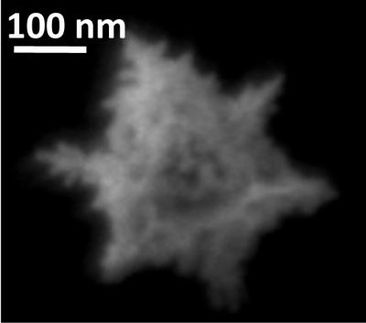Rings Made of Little Rods
Water droplets as templates: gold nanorods self-assemble into rings
Advertisement
Rod-shaped nanocrystals normally arrange themselves parallel to each other. Researchers at Rice University in Houston, Texas now report in the journal Angewandte Chemie completely unexpected behavior of nano-objects: the spontaneous self-assembly of polymer-coated metallic nanorods into ring-shaped structures. These rings, made of tiny gold rods, form within seconds when water droplets condense onto the surface of a solution of the rods in a nonpolar solvent.
Nanoscale objects organized into superstructures are interesting because the properties of such tiny particles depend not only on their composition, shape, and size, but also to a large extent on their spatial distribution and the degree of their ordering within a superstructure.
Bishnu P. Khanal and Eugene R. Zubarev coated gold nanorods with polystyrene. The tiny polymer chains in the coating stick out from the rodlike bristles. Their function is to make the rods soluble in organic solvents but insoluble in water - which is important for the self-assembly process. The nanorods are dissolved in dichloromethane, and then a carbon-coated grid is dipped into this solution. When the grid is pulled out, a thin layer of solution clings to it. The highly volatile dichloromethane quickly evaporates into the air, which intensely cools the surface of the liquid film. As a consequence, humidity from the air condenses onto the surface. Because water and dichloromethane are immiscible, the condensation forms tiny droplets of water. When the dichloromethane has largely evaporated, the last remnants of the solution form rings around the water drops. Once the dichloromethane has completely evaporated, the substrate warms back up to room temperature and the water droplets also begin to evaporate. This leaves behind ring-shaped structures made of nanorods. Images obtained with an electron microscope show that the nanorods in the rings are oriented randomly when their concentration in the original solution is high. However, at lower concentrations the result is truly amazing: The nanorods are oriented in a head-to-tail sequence along the edge of the ring.
Original publication: Eugene R. Zubarev et al.; "Rings of Nanorods"; Angewandte Chemie International Edition 2007, 46, No. 13, 2195-2198.
Topics
Organizations
Other news from the department science

Get the chemical industry in your inbox
By submitting this form you agree that LUMITOS AG will send you the newsletter(s) selected above by email. Your data will not be passed on to third parties. Your data will be stored and processed in accordance with our data protection regulations. LUMITOS may contact you by email for the purpose of advertising or market and opinion surveys. You can revoke your consent at any time without giving reasons to LUMITOS AG, Ernst-Augustin-Str. 2, 12489 Berlin, Germany or by e-mail at revoke@lumitos.com with effect for the future. In addition, each email contains a link to unsubscribe from the corresponding newsletter.


























































